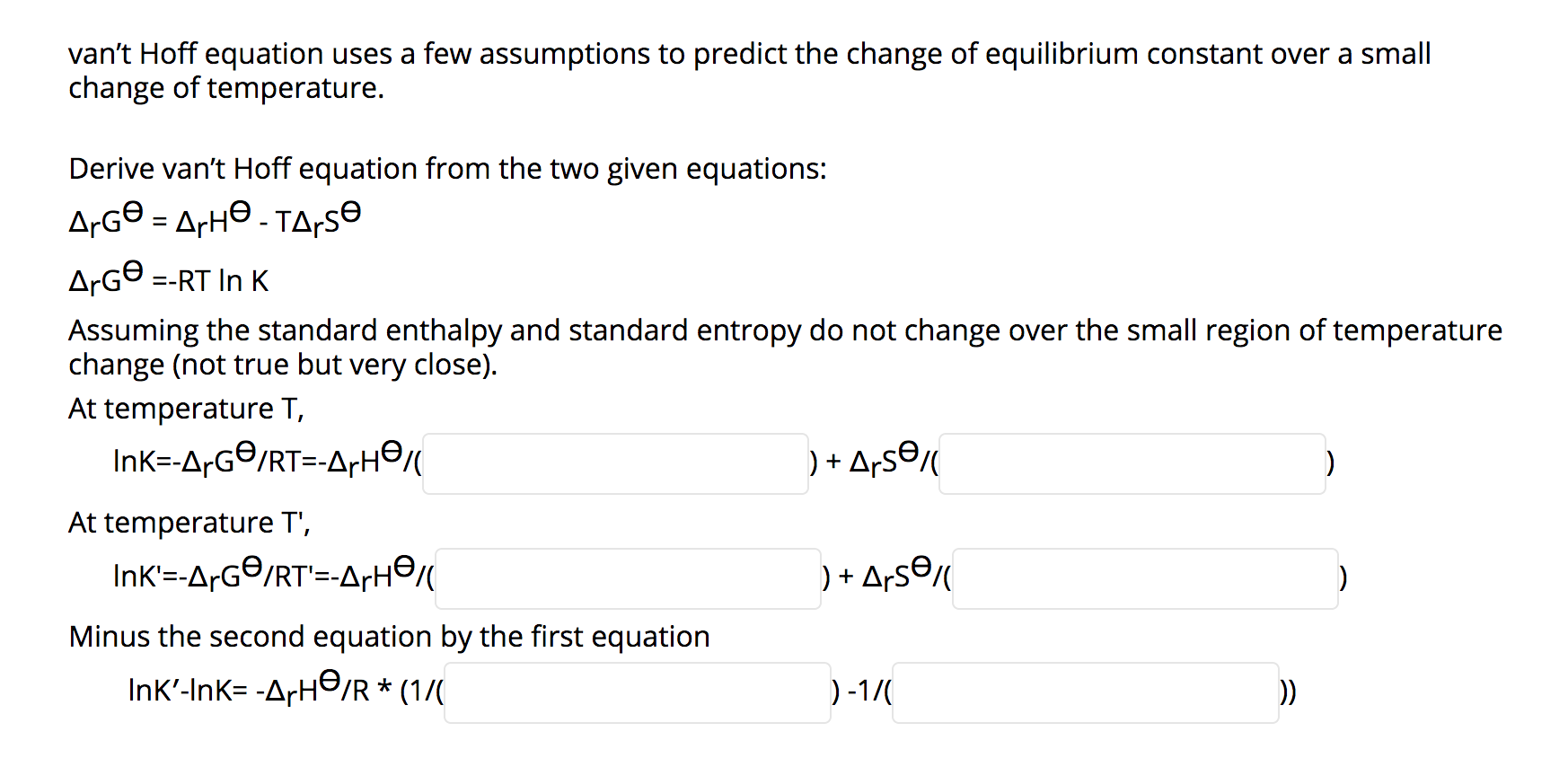van't Hoff equation uses a few assumptions to predict the change of equilibrium constant over a small change of temperature. Derive van't Hoff equation from the two given equations: A¡G© = ArH© - TA;SE %3D ArG® =-RT In K Assuming the standard enthalpy and standard entropy do not change over the small region of temperature change (not true but very close). At temperature T, InK=-A-G©/RT=-A+H© ) + Ars© At temperature T', InK'=-ArG©/RT'=-ArH© ) + ArsƏ« Minus the second equation by the first equation Ink'-Ink= -ArH☺/R * (1/( )-1/( ))
van't Hoff equation uses a few assumptions to predict the change of equilibrium constant over a small change of temperature. Derive van't Hoff equation from the two given equations: A¡G© = ArH© - TA;SE %3D ArG® =-RT In K Assuming the standard enthalpy and standard entropy do not change over the small region of temperature change (not true but very close). At temperature T, InK=-A-G©/RT=-A+H© ) + Ars© At temperature T', InK'=-ArG©/RT'=-ArH© ) + ArsƏ« Minus the second equation by the first equation Ink'-Ink= -ArH☺/R * (1/( )-1/( ))
Chemistry & Chemical Reactivity
10th Edition
ISBN:9781337399074
Author:John C. Kotz, Paul M. Treichel, John Townsend, David Treichel
Publisher:John C. Kotz, Paul M. Treichel, John Townsend, David Treichel
Chapter18: Principles Of Chemical Reactivity: Entropy And Free Energy
Section: Chapter Questions
Problem 101SCQ
Related questions
Question

Transcribed Image Text:van't Hoff equation uses a few assumptions to predict the change of equilibrium constant over a small
change of temperature.
Derive van't Hoff equation from the two given equations:
A¡G© = ArH© - TA;SE
%3D
ArG® =-RT In K
Assuming the standard enthalpy and standard entropy do not change over the small region of temperature
change (not true but very close).
At temperature T,
InK=-A-G©/RT=-A+H©
) + Ars©
At temperature T',
InK'=-ArG©/RT'=-ArH©
) + ArsƏ«
Minus the second equation by the first equation
Ink'-Ink= -ArH☺/R * (1/(
)-1/(
))

Expert Solution
This question has been solved!
Explore an expertly crafted, step-by-step solution for a thorough understanding of key concepts.
This is a popular solution!
Trending now
This is a popular solution!
Step by step
Solved in 5 steps with 5 images

Knowledge Booster
Learn more about
Need a deep-dive on the concept behind this application? Look no further. Learn more about this topic, chemistry and related others by exploring similar questions and additional content below.Recommended textbooks for you

Chemistry & Chemical Reactivity
Chemistry
ISBN:
9781337399074
Author:
John C. Kotz, Paul M. Treichel, John Townsend, David Treichel
Publisher:
Cengage Learning

Chemistry & Chemical Reactivity
Chemistry
ISBN:
9781133949640
Author:
John C. Kotz, Paul M. Treichel, John Townsend, David Treichel
Publisher:
Cengage Learning

Chemistry: The Molecular Science
Chemistry
ISBN:
9781285199047
Author:
John W. Moore, Conrad L. Stanitski
Publisher:
Cengage Learning

Chemistry & Chemical Reactivity
Chemistry
ISBN:
9781337399074
Author:
John C. Kotz, Paul M. Treichel, John Townsend, David Treichel
Publisher:
Cengage Learning

Chemistry & Chemical Reactivity
Chemistry
ISBN:
9781133949640
Author:
John C. Kotz, Paul M. Treichel, John Townsend, David Treichel
Publisher:
Cengage Learning

Chemistry: The Molecular Science
Chemistry
ISBN:
9781285199047
Author:
John W. Moore, Conrad L. Stanitski
Publisher:
Cengage Learning

Chemistry: Principles and Practice
Chemistry
ISBN:
9780534420123
Author:
Daniel L. Reger, Scott R. Goode, David W. Ball, Edward Mercer
Publisher:
Cengage Learning


Chemistry
Chemistry
ISBN:
9781305957404
Author:
Steven S. Zumdahl, Susan A. Zumdahl, Donald J. DeCoste
Publisher:
Cengage Learning